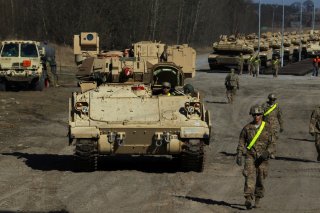The U.S. Sale of M1 Abrams Tanks to Poland Sends Clear a Message to Russia
There is little question that their acquisition will substantially enhance the capabilities of Poland’s ground forces in a pitched conflict with Russia.
Poland’s defense minister Mariusz Błaszczak has confirmed the country’s plans to buy as many as 250 M1A2 Abrams SEPv3 main battle tanks (MBTs). The announcement follows prior reports indicating that Warsaw is looking to refresh its aging stock T-72 and PT-91 tanks with a modernized MBT platform.
The first M1A2 shipments are scheduled to be delivered to the Polish military as early as 2022, according to Polish officials. Reuters reported that the contract is worth 23.3 billion zlotys—or $6 billion—and includes an additional logistics/training package that’s focused on infrastructure upgrades and ammunition procurements.
Whereas most arms import contracts are typically framed in diplomatically neutral terms, Błaszczak did not mince words in describing the reason behind Poland MBT purchase: "Of course this is a response to the challenges we face in terms of international security. Our task is to deter a potential aggressor. We all know where that aggressor is,” he said, in what is a clear reference to Russia.
Not only did Błaszczak cite a specific adversary, but he went as far as to identify the exact Russian product that Poland’s new M1A2’s are intended to counteract: “So we are ordering the most modern tanks. Tanks available in the best-equipped version, tanks that are combat-proven, tanks which were constructed to counter the most modern Russian T-14 Armata tanks,” he said. The SEPv3 revision introduced across-the-board improvements to the tried-and-true M1 Abrams formula, bringing a new radio system, revised infrared (FLIR) systems for enhanced target acquisition, a new electronic warfare system, auxiliary power unit for increased efficiency, and more. The T-14 Armata is Russia’s next-generation MBT platform, notably boasting an unmanned turret design with a 125-millimeter 2A82-1M smoothbore gun featuring autoloader compatibility.
Earlier this year, the Polish military conducted a massive wargame against the Western Military District—arguably the most capable and best-equipped of Russia’s five military districts. Dubbed “Winter-20,” the wargame involved Patriot missile systems, M142 HIMARS rocket launcher systems, and other examples of Poland’s latest military hardware. The outcome was nothing short of a crushing defeat. Poland’s Air Force and Navy were rapidly degraded and destroyed, while the country’s front-line battalions suffered a staggering loss rate of sixty to eighty percent. The original plan envisioned a twenty-two-day timeframe for repelling the Russian assault but, by the fifth day, Russian troops were already fighting for control of Warsaw on the Vistula River.
The specifics of the wargame remain unknown, with the Polish government telling reporters that “the winter exercise, its course and conclusions are classified information.” It is unclear whether or not T-14 Armata tanks, which are currently too few in number to make a meaningful battlefield impact, took part in the Winter-20 simulation. Given the confidentiality of the exercise, it is likewise impossible to assess the impact that 250 M1A2 SEPv3 tanks could have had on the course of the wargame. Though it is difficult to see exactly how these tanks could have altered the outcome of the wargame, there is little question that their acquisition will substantially enhance the capabilities of Poland’s ground forces in a pitched conflict with Russia. There may also be potential political benefits, with experts arguing that the purchase sends a clear message to Moscow about Washington’s commitment to NATO’s deterrence mission.
Mark Episkopos is a national security reporter for The National Interest.
Image: Reuters

